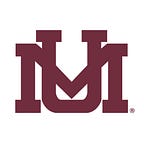Inspiring Innovation
UM’s new Innovation Factory churns out ideas, creativity and collaboration
By Jenny Lavey
There’s only one drip coffee maker in the kitchen. That decision was on purpose because waiting for caffeine encourages community.
Sparking a conversation, an idea, project or just a connection is exactly the point of UM’s Innovation Factory. The coffee is free because it’s a critical element to innovation, collaboration and creativity — the main ingredients for discovering what’s possible.
After all, innovation drives research, and “innovation is a central component of our research and creative activity mission at UM,” says UM Vice President for Research and Creative Scholarship Scott Whittenburg.
Drawing students and faculty from the arts, humanities, social sciences and STEM disciplines, UM recently dedicated space, staff and support for its new Innovation Factory.
The idea: Break down academic and program silos to foster partnerships and collaborations among students, community members and faculty, and provide the tools to bring ideas to life. The goal, Whittenburg says, is to “be more innovative than individual disciplines can imagine.”
And there’s plenty of space and equipment to do just that, thanks to a commitment to reuse and repurpose.
The former second floor of the UM Bookstore has been transformed with bright neon chairs and meeting tables surplussed from across campus. There’s a corner dedicated to tinkerers with various odds and ends of technological components. The work lab hosts a vinyl cutter, a laser cutter, a row of 3-D printers and a healthy supply of art supplies and various tools. There’s also a wall for students to post their resumes and various skillsets.
The space, Whittenburg says, “is a prototype and small piece of a larger vision” but has the components to provide a place for “myriad departments to begin thinking about collaboration.”
The eclectic space is peppered with Post-It notes with handwritten answers to the question “What does innovation mean?” and stories and quotes about creativity and transcending boundaries. The room feels more like the headquarters of an urban tech startup than a traditional classroom.
That’s the point.
“The idea is that this space is an incubator for creativity and a disruption to silos,” says Elizabeth Dove, a UM art professor. “We wanted to purposely make the space bright and open so that nothing feels like it’s off limit or necessarily has boundaries.”
Dove, along with UM art Professor Brad Allen, are co-designing the IF, though they’re quick to note the space isn’t owned by any singular department or program.
Rather, it’s a shared campus entity — “aa creative hub that’s open to everybody either to get help solving problems or to come up with new ones that invite a lot of different perspectives,” Allen says.
Shared collaboration is at the very center of IF. The factory is modeled after a network of global Design Factories, which are designated innovation hubs in universities and research organizations with missions to drive change and create innovation.
The Design Factory Global Network includes 11 sites in as many countries, with only two in the United States at Philadelphia University and Pace University in New York.
UM’s version, according to Dove, has serious potential for capturing Montanans’ natural penchant for resourcefulness while pairing it with Missoula’s booming tech and entrepreneurial industries.
“I think what gives us an edge and what makes us unique is that as a state and as a community, we’re used to resource scarcity,” Dove says. “That’s an asset when we think about what’s possible when we encourage students to step outside of their unit and invite local businesses and startups in to pair their needs with the University and vice versa.”
To Dove, that might look like a company wanting advice on website redesign — and they may find a graphic design student desiring project work. It may resemble a student in data information needing a visual depiction, stimulating a connection with an art student. The Innovation Factory might house a meeting space for students and community members to discuss an entrepreneurial project or provide a trajectory for a faculty member wanting to connect across campus with students or programs in a particular subject.
Allen says the very nature of engaging across disciplines is the kind of modern, innovative curriculum contemporary students receive at UM.
“Education has changed dramatically,” he says. “we are serving students, and we need to provide the space for them to tell us what skills they want to pursue, what experiences they want.”
Paul Gladen, an 11-year veteran of Missoula’s startup and tech community who has helped launch several business ventures and currently directs UM’s Blackstone LaunchPad, expects some of the ideas born in the factory to have commercial applicability.
That’s why the Blackstone LaunchPad, which provides idea exploration, startup consulting, venture coaching and mentorship to UM faculty, staff, alumni and students, has made IF home.
“The Innovation Factory is a space designed for what we’re trying to do, which is to explore entrepreneurship stimulated by innovation,” Gladen says. “It’s a natural home for the Blackstone LaunchPad to show how an interdisciplinary perspective can foster problem solving.”
Learning to navigate the transition from a project to a potential business serves as an antidote for the all-too-popular idea that a liberal arts education has waning value, Gladen says.
“From an entrepreneurial and business perspective, young people need to be effective problem-solvers and communicators,” he says. “Entrepreneurship is enhanced by a liberal arts education because it can provide skills that are essential components for success.”
Gladen cited several successful Missoula-based tech companies founded by liberal arts graduates, including Submittable and TOMIS, which were driven “out of ideas that resonate with Montanans and inspire others.”
Eventually, Gladen says he hopes IF and Blackstone can enable diverse people to engage in “high levels of engagement and participation that sow the seeds for something bigger.” •
